#Delphinium tricorne
Text

Dwarf Larkspur
Delphinium tricorne
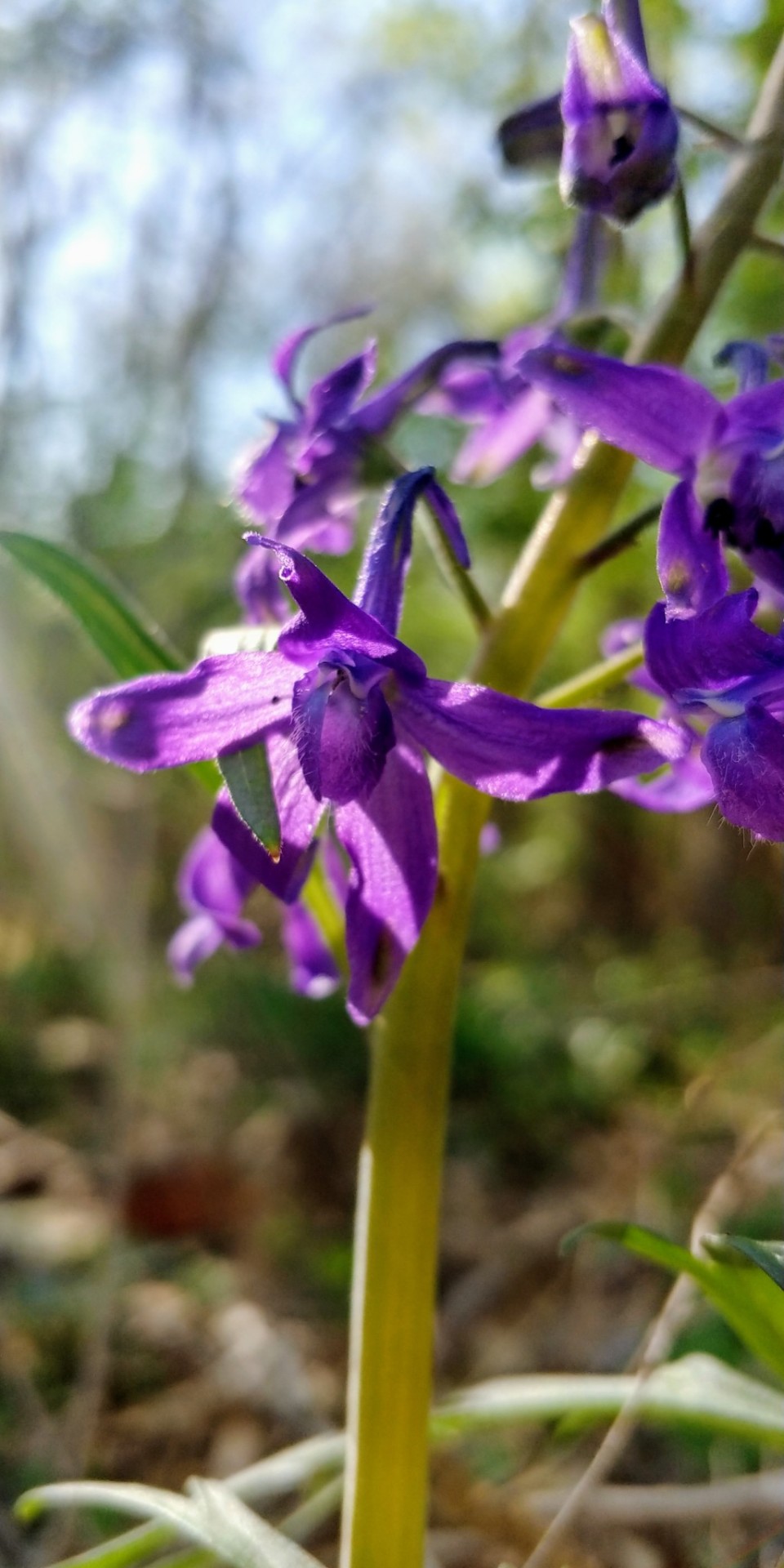
A favorite of hummingbirds and butterflies when it blooms. This spring ephemeral is native to the central and eastern United States. The flowers can range in color from white to all shades of purple.
April 12th, 2023
St. Louis County, Missouri, USA
Olivia R. Myers
@oliviarosaline
#botany#plants#flowers#Delphinium tricorne#delphinium#ranunculaceae#larkspur#fairycore#cottagecore#forestcore#naturecore#the ozarks#Missouri#nature#woods#forest#hummingbird flowers#purple#purple flowers#violet#wildflowers#native plants#native flowers#plant photography#flower photography#nature photography#exploring#hiking#missouri nature#spring ephemerals
40 notes
·
View notes
Photo

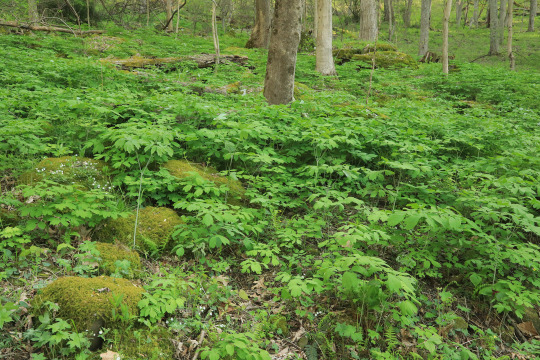
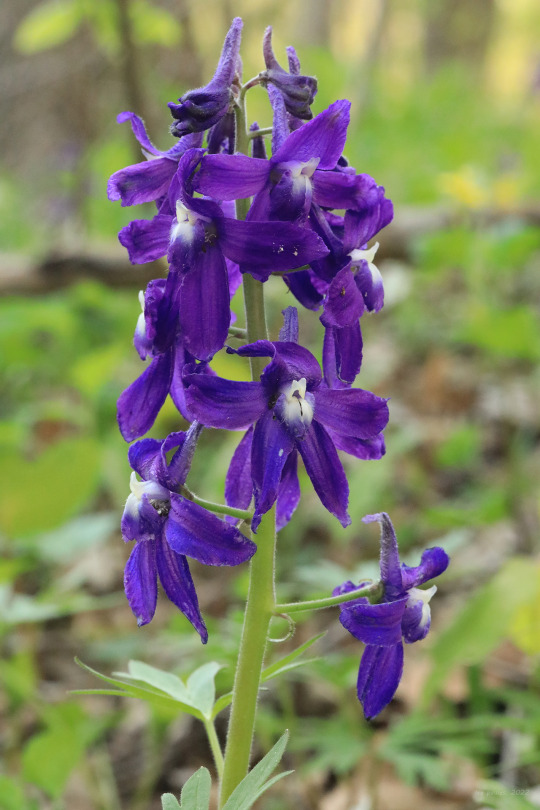
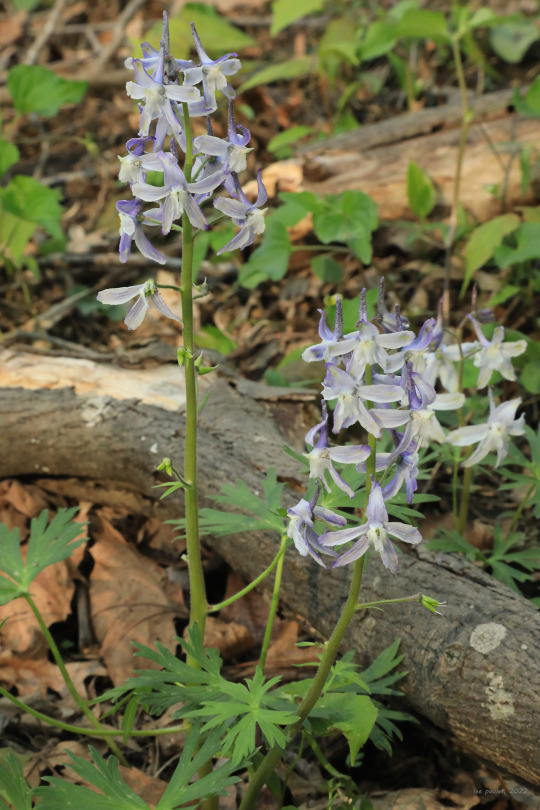
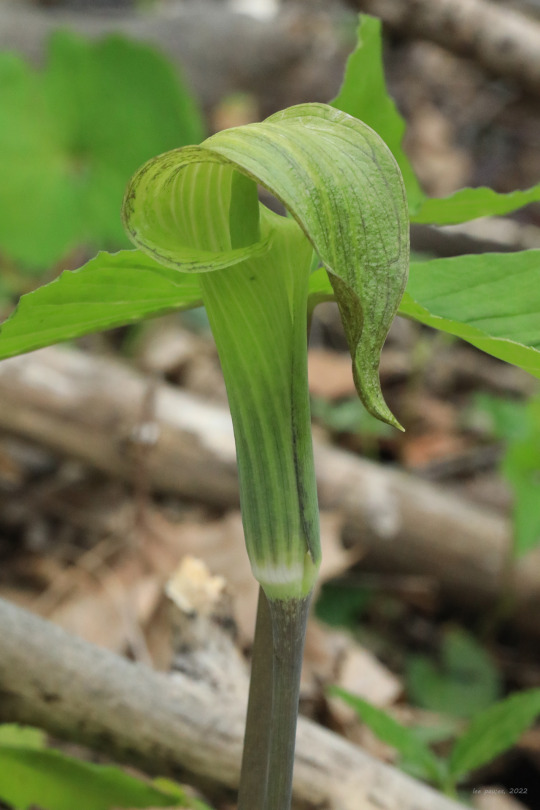

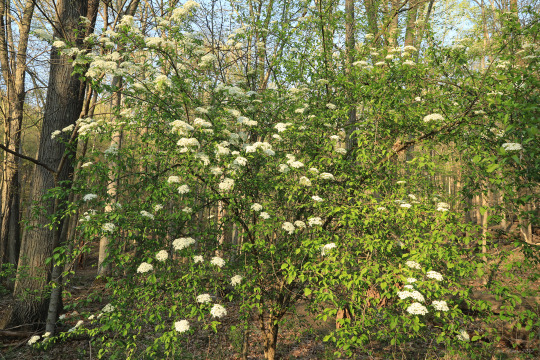
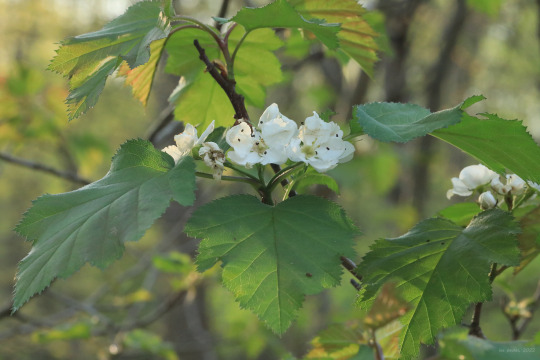
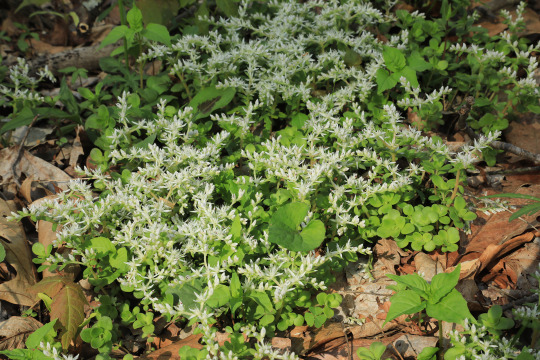
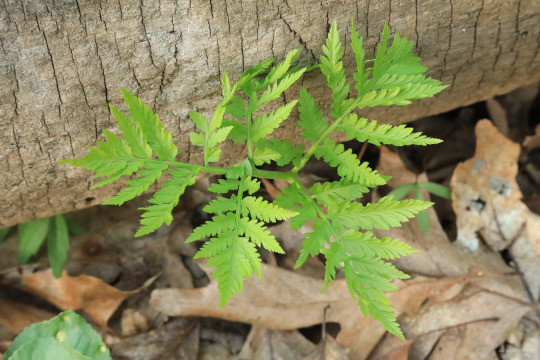
Elizabeth’s Woods, part of the Toms Run Preserve system, is located just a few minutes from where I work: a convenient little Eden on whose gentle, winding trails I frequently relieve my accumulated angst and stress. In early spring, especially in the late afternoon, the old woods take on a soft, burnished glow that penetrates every leaf and flower, exposing nature’s finest filigree - veins, venules, stigmas, anthers and more - in intricate detail.
From top: a rocky alcove overrun by giant blue cohosh (Caulophyllum giganteum); a purple variation of dwarf larkspur (Delphinium tricorne), a toxic little beauty whose flowers remind me of parachuting wizards; an even lovelier lavender and white variation of the same plant; a tall and stately Jack-in-the pulpit (Arisaema triphyllum); a smooth blackhaw viburnum (Viburnum prunifolium), equally beautiful in spring and fall, when its foliage turns reddish-purple; bigfruit hawthorn (Crataegus macrosperma) with new spring blossoms; woodland stonecrop (Sedum ternatum), whose massed white flowers look like clumps of snow in the leaf litter; and an unfurling Virginia grape fern (Botrypus virginianus), also known as rattlesnake fern due to its tendency to grow in the same habitats in which rattlesnakes occur.
#appalachia#vandalia#west virginia#spring#flora#wildflowers#caulophyllum giganteum#giant blue cohosh#delphinium tricorne#dwarf larkspur#arisaema triphyllum#jack-in-the-pulpit#viburnum prunifolium#blackhaw viburnum#smooth blackhaw viburnum#crataegus macrosperma#bigfruit hawthorn#sedum ternatum#woodland stonecrop#botrypus virginianus#virginia grape fern#rattlesnake fern#elizabeth's woods#toms run preserve#west virginia land trust
145 notes
·
View notes
Text

Ohio Spring Wildflower Field Guide
#delphinium tricorne#Dwarf larkspur#spring larkspur#larkspur#Delphinium#flower#flowers#spring flowers#spring#floral#wildflowers#wild flowers#ohio#ohio wild flowers#botany#april#may
0 notes
Photo





A trapse by the hillside clearings with spires of purple, blue, and white illuminated by the sunlight.
A section of Richardson Preserve, mesic and more rich section of hillside that was cleared of Amur Honeysuckle a few years ago is now a spectacle of ephemeral forbes: Pale form and purple form dwarf larkspur ( Delphinium tricorne ) and blue eyed mary ( Collinsia verna ) make up most of the noticeable scenery within the forest floor mosaic, Replacing the grounds that were covered in trout lily and toothwort not to long ago, Phlox divaricata and Anemone quinquefolia along with a few Trillium species are still hanging on in places occasionally dappled with the small yellow flowered Ranunculus species. By now the Claytonia spp, fumeworts, and Erigenia bulbosa are already going to seed. Transitioning now is a mid season array of Chaerophyllum procumbens, Podophyllum peltatum, and Osmorhiza claytoni.
I may need to go pull some honeysuckle on the hillside soon before it gets out of hand again. Ecological stewardship is critical for protecting natural landscapes and the ecological benefits and connections they have.
#Collinsia verna#delphinium tricorne#collinsia#Delphinium#forestcore#cottagecore#meadowcore#ecology#wildflowers#spring#ohio#plantblr#botany#kawaii#fairycore
68 notes
·
View notes
Photo

Roadside dwarf larkspur
6 notes
·
View notes
Photo
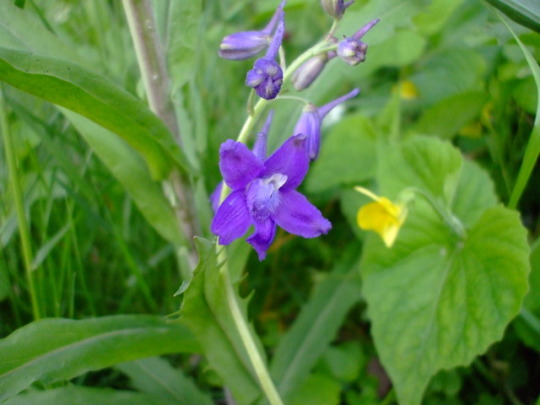
Delphinium tricorne
Want wildflower seeds? Check out our Ebay: https://www.ebay.com/str/lakesideseeds
#Delphinium tricorne#wildflower#wildflowers#wild flower#wild flowers#flower#flowers#plant#plants#native#natives#wildflower seed#wildflower seeds#seed#seeds#nature#nature photography#photography#garden#gardening#gardens
20 notes
·
View notes
Photo

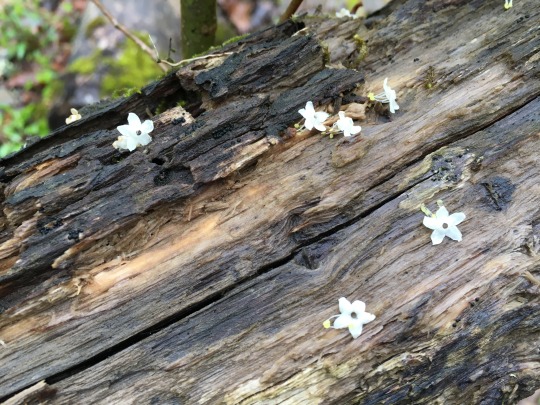




Photos from a recent trip to Blackburn Bluffs Preserve in northern Arkansas. I was lucky enough to be able to camp here for a couple of days and participate in a BioBlitz on the 300 acre property. We had a pretty good rainfall the first night of camping so there was plenty of water on the property and a higher creek crossing than usual but the wildflowers were in full bloom. I’ll be adding more photos from this trip in the days to come.
#wildflowers#trillium#larkspur#dogwood#viburnum#ecology#biology#jack in the pulpit#botany#nature hikes#hiking
13 notes
·
View notes
Text
Growing Larkspur Flower-How to Grow and Care for Larkspur, growing conditions & Popular Larkspur Types.
Larkspur Flower- Delphinium is a genus of about 300 species of perennial flowering plants in the family Ranunculaceae, native throughout the Northern Hemisphere and also on the high mountains of tropical Africa. The genus was erected by Carl Linnaeus.
If you’ve tried to grow delphiniums without success, you might want to try larkspur flowers instead. All members of the genus Delphinium are toxic to humans and livestock. The common name larkspur is shared between perennial Delphinium species and annual species of the genus Consolida
This plant is the member of the Delphinium family and is available in more than 60 varieties. Its varieties range in height from one to seven feet. The best part about these plants is that its flowers bloom in the early spring while various flowers are weeks away.
Growing larkspur flowers (Consolida sp.) provides tall, early season color in the spring landscape. Once you learn how to grow larkspur, you will likely include them in the garden year after year.
Larkspur is a classic cottage garden staple that produces great cut flowers. With airy stalks of blue blossoms, this plant adds a gracefulness to any garden and looks good in masses or mixed with other perennials and annuals.
Larkspur vs. Delphinium :
A very close relative of larkspur, delphinium looks almost identical in many aspects, but a few differences set these two plants apart. Delphinium tends to be a perennial species, whereas larkspur is an annual. Foliage of larkspur is finer textured than delphinium. When it comes to blooms, delphinium flowers are densely born on spikes while individual blossoms tend to be much larger than larkspur. With those few exceptions, general plant care and maintenance is basically the same.
How to grow Larkspur Flower :
Most annual larkspur plants are grown from seeds, though planting larkspur seeds can be challenging. When planting larkspur seeds, they must have a cold period before germination. larkspur can thrive in a wide soil pH range, but anything between 5.7 and 7.0 is ideal. These plants aren’t fussy, but they prefer moderately rich, moderately loose, well-draining soil.
Unlike their delphinium cousins, larkspur are hardy plants that don’t need heavy staking from the beginning. They’re actually pretty easy to care for after they’ve sprouted and grown a few true leaves.
The seeds will not germinate in temperatures that go above 65 degrees Fahrenheit. Darkness is required for germination. Seeds do not germinate well when soil temperatures are above 55°F (13°C). Does best where summers are cool.
They’re actually pretty easy to care for after they’ve sprouted and grown a few true leaves.If you do find that the stalks need support, drive a wooden stake down into the soil three inches behind the flower stalk and affix the stalk to the stake with a piece of stretch tie.
Optimal growing conditions for Larkspur Flower :
They can tolerate most soils, but if you want the best results, go for light, well-draining soil. If your area has heavy soils, you can amend them with compost or manure. Larkspur plants grow well in full sun, as long as the soil is slightly moist. They need less moisture than delphiniums, but they don’t bloom well in hot and dry conditions.
Water your plant in the summer if rainfall is under 1 inch per week.If you want to mix and match a few flowers in your garden, you can plant larkspur with other native and cottage flowers. Why not add a few coreopsis, daisies, lavender, black-eyed Susans, or coneflowers?
Top 10 Popular Larkspur Types-
· Black Knight Larkspur (Delphinium 'Black Knight')
· Galahad Larkspur (Delphinium 'Galahad')
· Astolat Larkspur (Delphinium Astolat Group)
· Guardian Lavender Larkspur (Delphinium elatum 'Guardian Lavender')
· Dwarf Larkspur (Delphinium tricorne)
· Blue Mirror Larkspur (Delphinium 'Blue Mirror')
· Cassius Larkspur (Delphinium 'Cassius')
· Summer Skies Larkspur (Delphinium 'Summer Skies')
· Golden Larkspur (Delphinium luteum)
· Red Lark Larkspur (Delphinium 'Red Lark')
Insects and Diseases that affect Delphinium Flowers :
Larkspurs are prone to fungal diseases most notably Sclerotium rot which yellows leaves and wilts plant. It is also affected by mildew. Diseased plants should be removed immediately in order to avoid the disease from spreading.
Insects hardly affect Larkspur. Organic or chemical insect repellents have proved to be highly effective against most pests.
Managing Pests And Disease :
Unlike its cousin, delphinium, larkspur are reliably pest and disease resistant. As far as pests go, your biggest foes will be aphids and slugs.
If you see clusters of aphids sucking the life from your Consolida buds or stalks, spray them with a neem oil-based insecticide, like this one from Arbico Organics.
The next day, spray the carcasses off with a blast of water from the hose. Reapply the neem oil every few days, or anytime you see a sign of a living aphid.
Slugs and snails chew holes in the leaves but generally leave flowers alone.
To get rid of the squishy pests, spread Sluggo Maxx, available from Arbico Organics, around the plants. I love this stuff because it’s safe to use around pets.
Learn more about managing slugs and snails in this guide.
All parts of Consolida plants are toxic to humans and animals alike when ingested, so deer, rabbits, moose, and other critters avoid them.
If you live in the Pacific Northwest or a similarly rainy clime, watch out for various fungal diseases that can develop, like powdery mildew, root rot, and crown rot.
Powdery mildew leaves white moldy spots all over the leaves.
To treat an infection, spray the plant with a copper fungicide product, like this one from Arbico Organics.
Uses :
The juice of the flowers, particularly D. consolida, mixed with alum, gives a blue ink. All plant parts are poisonous in large doses, especially the seeds, that contain up to 1.4% of alkaloids.
Toxicity of Larkspur Flower :
All parts of these plants are considered toxic to humans, especially the younger parts, causing severe digestive discomfort if ingested, and skin irritation. Larkspur, especially tall larkspur, is a significant cause of cattle poisoning on rangelands in the western United States. Larkspur is more common in high-elevation areas, and many ranchers delay moving cattle onto such ranges until late summer when the toxicity of the plants is reduced. Death is through cardiotoxic and neuromuscular blocking effects, and can occur within a few hours of ingestion. All parts of the plant contain various diterpenoid alkaloids, typified by methyllycaconitine, and are very poisonous.
1 note
·
View note
Photo
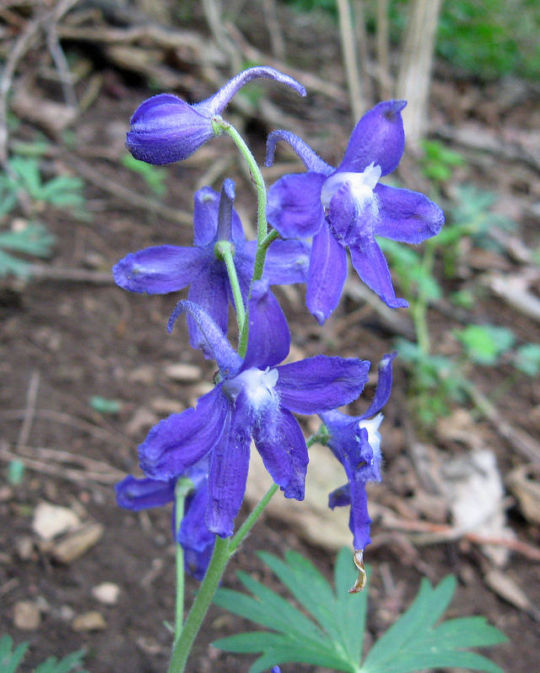
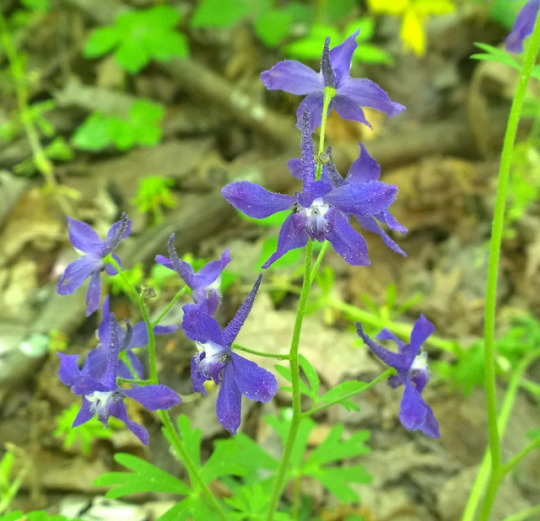
Dwarf larkspur and sometimes spring (Delphinium tricorne) is a flowering plant in the buttercup family. It is native to the eastern United States.It a perennial that sends up long, stringy thin stems with few leaves and bears attractive flowers in shades of blue. D. tricorne should be treated as a potentially poisonous plant. This species has long been regarded as poisonous to livestock. Lower picture by Tim Martin.
58 notes
·
View notes
Photo
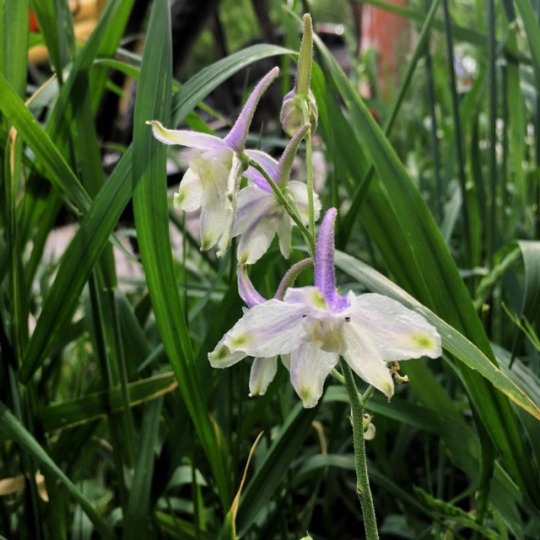
Spring larkspurs (delphinium tricorne) #larkspur #delphinium #nationalwildflowerweek #tanasitrails
1 note
·
View note
Photo

Larkspur. (Delphinium tricorne) this plant is sort of like aconite's less-intense cousin (wolfsbane lite?), containing the nerve-blocking alkaloid lycoctonine. Not as intense but still poisonous. . . . . . #nature #natural #herbal #plant #herbalmedicine #medicinalherbs #naturalhealth #naturopathy #holistichealth #organic #wildflowers #poison
#organic#plant#herbal#poison#nature#medicinalherbs#naturalhealth#holistichealth#natural#wildflowers#herbalmedicine#naturopathy
8 notes
·
View notes
Text
You Don’t Want to Miss the Spring Train to Serendipity
Rose and I had an idea for a family homecoming last month. We hosted our kids for a week on the spring train to Serendipity.
Our son lives with his wife in London; our daughter and granddaughter live in Bellingham, WA. The plan worked. It was great to have the kids home.
Our children have always enjoyed the outdoors—in backyards, parks, gardens and the wild. Molly and Cooper, when they were young, even made a little walk-around money, collecting black-eyed Susan seeds for Jelitto Perennial Seeds, my old employer.
Cooper, Story, Rufus and Rose in George Rogers Clark Park in Louisville, KY.
Molly and Story at Bernheim Forest and Research Arboretum in Clermont, KY.
Our granddaughter, Story, has devoured nature’s surprises from a very young age. She’s 12 now and shows no signs of letting up. This past January, for instance, Story took a New Year’s Day polar plunge into Bellingham’s chilly Lake Padden. While visiting us, she jumped into Salvisa’s Salt River with her friend Sofia.The river’s temperature was a chilly 55F. Story is a Pisces water bug.
I myself am astrologically challenged. I prefer a warm threshold above 70F before I dip my toes in the water.
I don’t want to think about summer’s heat and oppressive humidity just as Kentucky begins to shed dormancy, when skies are blue and temperatures are mild. I outlasted winter by hoping with every fiber to be reborn in April. I succeeded. Sometimes spring blooms and lucky stars are waiting at the station. You don’t want to miss Serendipity. Summer can wait.
Seven years ago, we began binge-planting 500 daffodil bulbs in a two-and-a-half-acre field, adjacent to the Salt River. We kept up the fall ritual for five years. Peak daffodil bloom was a week late this year, but it was serendipitously perfect. It was time for a party.
The chartreuse maple catkins arrived at the Serendipity platform in early April. If your eyes were peeled, you could see 100-foot trees in the distance, beginning to light up woodlands. Before a week went by, the redbud blooms splashed roadsides, followed lickety-split by white-flowering dogwoods. Spring beauties gave way to carpets of mayapples, woodland phlox and larkspur.
Mayapples with woodland phlox and Jacob’s ladder.
Larkspur, Delphinium tricorne.
Cooper, Kylie, Molly and Story returned to their respective homes to catch a glimpse of what spring had to offer in London and Bellingham. I’m waiting for field reports on what their daffodils looked like, but Salvisa’s never looked better.
There was no stopping springtime in Kentucky. Everyone I’ve asked around here agreed with the assessment of April’s abundance. I haven’t met a naysayer yet, though I remember when old timers used to preach the flipside of too much of a good thing. “We’re going to pay for it,” they would say. Heaven help us.Surely, we can hold onto this surprising spring goodness for a few more weeks.
When the daffodils finished blooming in the bottomland, they were followed by beaked corn salad, Valerianella radiata, that popped up voluntarily and keeps spreading magnificently in the wet bottomland it prefers. A record rainfall helped last year. The leaves of this native annual have a delicious lettuce-like flavor. We mow the field a month after the beaked corn salad is finished blooming in order to allow the seed to ripen and the daffodil foliage to go dormant.
Beaked corn salad in Salvisa.
The “spicily perfumed,” white-flowering witch alder, Fothergilla major, was planted intentionally in our garden 20 years ago. The golden ragwort, Senecio aureus, muscled its way in ten years ago. The unassuming yellow daisy made itself at home along a built dry creek bed designed and built by Bruce Carnahan for storm water drainage. I couldn’t have dreamed up the plant combination but I was happy with the surprise. The golden ragwort is a great, native groundcover, even though some might argue that it is a weedy thug.
Fothergilla major and golden ragwort.
I play it safe to avoid a runaway train—the possibility of thousands of seeds blowing away in every direction. I cut most of the blooms as soon as soon they’re finished. I don’t mind a few odd seedlings popping up. I am happy to have Fothergilla and a ribbon of flowering Senecio aureus parked at the railway station.
The dainty blooms of leatherwood (Dirca) and spicebush (Lindera) faded just as two sassafras trees began blooming for the first time. I started the sassafras from seeds given to me years ago by Bruce Eveslage. He collected them from his place across the Ohio River in Floyds Knobs, Indiana. One tree is male; the other female—essential for seed set. I can already imagine a crop of dark blue seeds, hanging from bright red stems.
Noble Boswell took me into the woods, across the river for a late afternoon hunt for morels. Noble, a gifted woodsman with a sharp eye, said morels (he calls them dry land fish) could be found when the oak leaves are the size of a squirrel’s ear. Noble’s a pro. He found a dozen or so morels.
I found one.
My sister Nancy was visiting with her friend Meg. I cut my one morel into four pieces and cooked them on the stovetop in olive oil with salt and pepper. “That’s it?” they asked, pointing the finger at their miniscule portions. Rose joined the laughter but they agreed: the miniscule mushroom slivers were tasty.
Sofia, Story, Salvisa, daffodils 040719
What a wonderful April.
May we all be blessed with sun-drenched dreams of an eternal train ride of spring blooms, sprinkled with a few extra morels.
You Don’t Want to Miss the Spring Train to Serendipity originally appeared on GardenRant on May 1, 2019.
from Gardening https://www.gardenrant.com/2019/05/you-dont-want-to-miss-the-spring-train-to-serendipity.html
via http://www.rssmix.com/
0 notes
Text

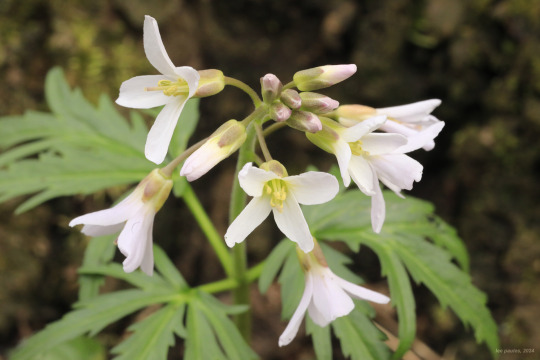

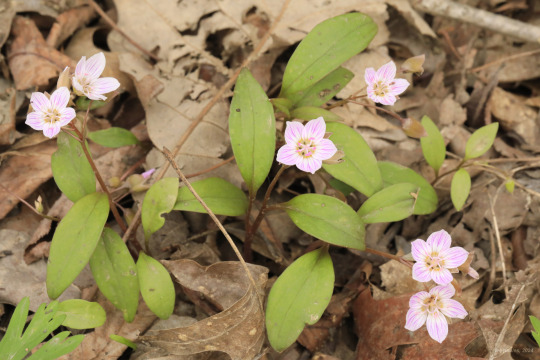
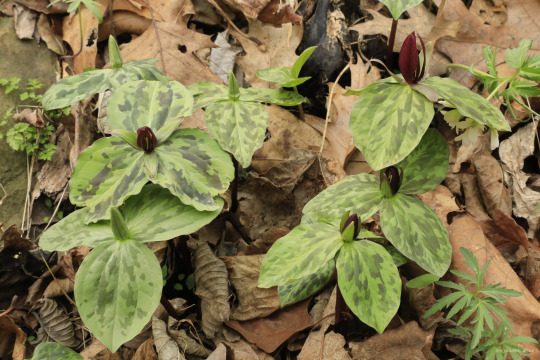


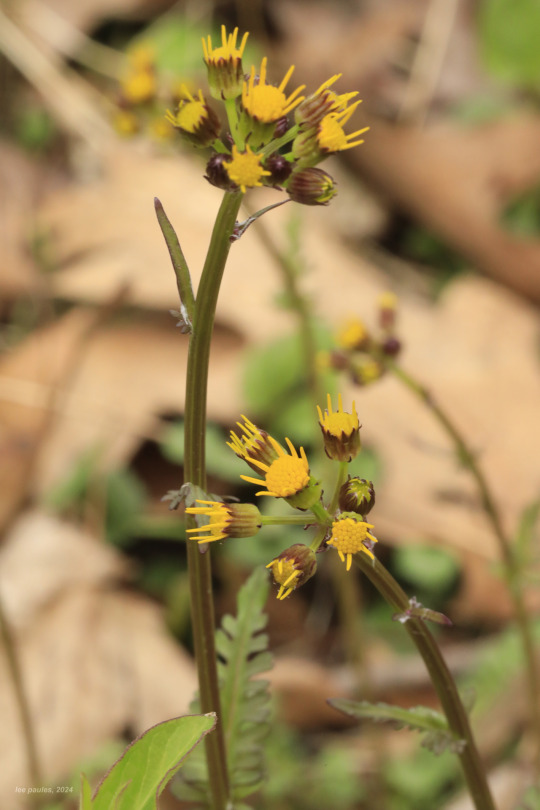


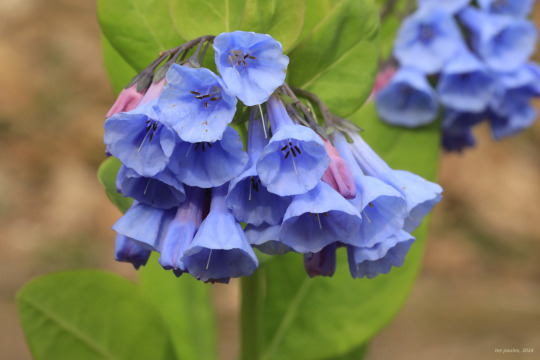
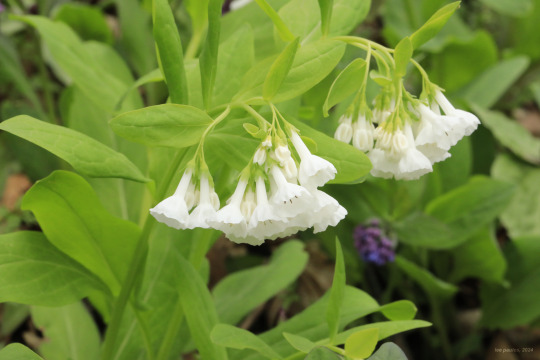

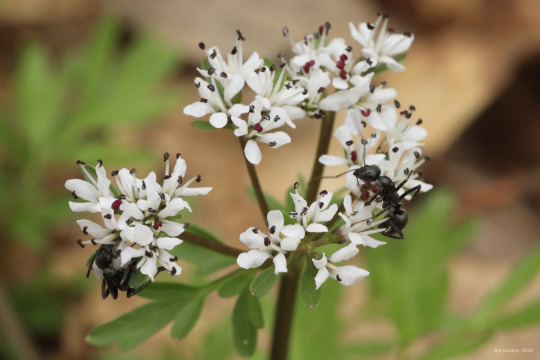


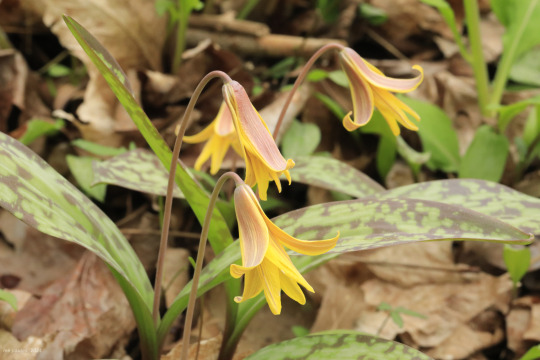



An Easter bouquet of some of Central Appalachia's finest spring wildflowers, courtesy of Core Arboretum at West Virginia University.
From top: cutleaf toothwort (Cardamine concatenata); Virginia spring beauty (Claytonia virginica); Carolina spring beauty (Claytonia caroliniana); sessile trillium (Trillium sessile); twinleaf (Jeffersonia diphylla); immature golden ragwort (Packera aurea); dwarf larkspur (Delphinium tricorne); Virginia bluebells (Mertensia virginica), including a rare white-flowered variation; woodland phlox (Phlox divaricata), also known as wild blue phlox; harbinger of spring (Erigenia bulbosa), also known as pepper and salt; Dutchman's breeches (Dicentra cucullaria); downy yellow violet (Viola pubescens); yellow trout lily (Erythronium americanum), also known as dog-tooth violet; and celandine poppy (Stylophorum diphyllum), also known as wood poppy.
#appalachia#vandalia#west virginia#spring#wildflowers#flora#core arboretum#west virginia university#morgantown
82 notes
·
View notes
Text
You Don’t Want to Miss the Spring Train to Serendipity
Rose and I had an idea for a family homecoming last month. We hosted our kids for a week on the spring train to Serendipity.
Our son lives with his wife in London; our daughter and granddaughter live in Bellingham, WA. The plan worked. It was great to have the kids home.
Our children have always enjoyed the outdoors—in backyards, parks, gardens and the wild. Molly and Cooper, when they were young, even made a little walk-around money, collecting black-eyed Susan seeds for Jelitto Perennial Seeds, my old employer.
Cooper, Story, Rufus and Rose in George Rogers Clark Park in Louisville, KY.
Molly and Story at Bernheim Forest and Research Arboretum in Clermont, KY.
Our granddaughter, Story, has devoured nature’s surprises from a very young age. She’s 12 now and shows no signs of letting up. This past January, for instance, Story took a New Year’s Day polar plunge into Bellingham’s chilly Lake Padden. While visiting us, she jumped into Salvisa’s Salt River with her friend Sofia.The river’s temperature was a chilly 55F. Story is a Pisces water bug.
I myself am astrologically challenged. I prefer a warm threshold above 70F before I dip my toes in the water.
I don’t want to think about summer’s heat and oppressive humidity just as Kentucky begins to shed dormancy, when skies are blue and temperatures are mild. I outlasted winter by hoping with every fiber to be reborn in April. I succeeded. Sometimes spring blooms and lucky stars are waiting at the station. You don’t want to miss Serendipity. Summer can wait.
Seven years ago, we began binge-planting 500 daffodil bulbs in a two-and-a-half-acre field, adjacent to the Salt River. We kept up the fall ritual for five years. Peak daffodil bloom was a week late this year, but it was serendipitously perfect. It was time for a party.
The chartreuse maple catkins arrived at the Serendipity platform in early April. If your eyes were peeled, you could see 100-foot trees in the distance, beginning to light up woodlands. Before a week went by, the redbud blooms splashed roadsides, followed lickety-split by white-flowering dogwoods. Spring beauties gave way to carpets of mayapples, woodland phlox and larkspur.
Mayapples with woodland phlox and Jacob’s ladder.
Larkspur, Delphinium tricorne.
Cooper, Kylie, Molly and Story returned to their respective homes to catch a glimpse of what spring had to offer in London and Bellingham. I’m waiting for field reports on what their daffodils looked like, but Salvisa’s never looked better.
There was no stopping springtime in Kentucky. Everyone I’ve asked around here agreed with the assessment of April’s abundance. I haven’t met a naysayer yet, though I remember when old timers used to preach the flipside of too much of a good thing. “We’re going to pay for it,” they would say. Heaven help us.Surely, we can hold onto this surprising spring goodness for a few more weeks.
When the daffodils finished blooming in the bottomland, they were followed by beaked corn salad, Valerianella radiata, that popped up voluntarily and keeps spreading magnificently in the wet bottomland it prefers. A record rainfall helped last year. The leaves of this native annual have a delicious lettuce-like flavor. We mow the field a month after the beaked corn salad is finished blooming in order to allow the seed to ripen and the daffodil foliage to go dormant.
Beaked corn salad in Salvisa.
The “spicily perfumed,” white-flowering witch alder, Fothergilla major, was planted intentionally in our garden 20 years ago. The golden ragwort, Senecio aureus, muscled its way in ten years ago. The unassuming yellow daisy made itself at home along a built dry creek bed designed and built by Bruce Carnahan for storm water drainage. I couldn’t have dreamed up the plant combination but I was happy with the surprise. The golden ragwort is a great, native groundcover, even though some might argue that it is a weedy thug.
Fothergilla major and golden ragwort.
I play it safe to avoid a runaway train—the possibility of thousands of seeds blowing away in every direction. I cut most of the blooms as soon as soon they’re finished. I don’t mind a few odd seedlings popping up. I am happy to have Fothergilla and a ribbon of flowering Senecio aureus parked at the railway station.
The dainty blooms of leatherwood (Dirca) and spicebush (Lindera) faded just as two sassafras trees began blooming for the first time. I started the sassafras from seeds given to me years ago by Bruce Eveslage. He collected them from his place across the Ohio River in Floyds Knobs, Indiana. One tree is male; the other female—essential for seed set. I can already imagine a crop of dark blue seeds, hanging from bright red stems.
Noble Boswell took me into the woods, across the river for a late afternoon hunt for morels. Noble, a gifted woodsman with a sharp eye, said morels (he calls them dry land fish) could be found when the oak leaves are the size of a squirrel’s ear. Noble’s a pro. He found a dozen or so morels.
I found one.
My sister Nancy was visiting with her friend Meg. I cut my one morel into four pieces and cooked them on the stovetop in olive oil with salt and pepper. “That’s it?” they asked, pointing the finger at their miniscule portions. Rose joined the laughter but they agreed: the miniscule mushroom slivers were tasty.
Sofia, Story, Salvisa, daffodils 040719
What a wonderful April.
May we all be blessed with sun-drenched dreams of an eternal train ride of spring blooms, sprinkled with a few extra morels.
You Don’t Want to Miss the Spring Train to Serendipity originally appeared on GardenRant on May 1, 2019.
from GardenRant http://bit.ly/2Y3bzJl
0 notes
Photo





Drier hillside, Richardson preserve, section of depositional karst conglomerate based hillside. Open woodland sections with dry soils surrounded by mesic zones often have their own unique forbe community compared to the rest of the forest. In this photoset the light glazes over many different members that make up this mixing composition. twords the base of the hill we see normal mesic riparian floodplain and flat species such as Phlox divaricata, Thalictrum thalictroides, Geranium maculatum, Polemonium reptans, Polemonium reptans. A species more prominent in mesic areas yet mixed into all sections of the forest floor mosaic is Delphinium tricorne, Collinsia verna ( an annual) too. The drier sections show signs of mainly Packera obovata, though what’s also apparent in the drier sections is what’s to come, Camassia scilloides and Allium cernuum.
Adaptation to water requirements and being more associated to a niche based on soil chemistry can be a fairly obvious thing once you see your plant communities change, species do prefer an active site and will “compete” or rather fill in the niche better, have higher fetality(reproductive success of seed made), recruitment ( new individuals that actively are found and may establish) and Natality( a true function of recruitment, a rate at which the species propagates(new recruits/total population in area)), if site requirements favor the species over another that is coevolved in the same region. Looking at these mosaics also gives you a spatial reference for the size of the habitat/deposit/site of interest and may even tell you the potential for other species that are of more interest that could be hidden. Zones where more establishment long term meet a zone or area with high average mortality or low average species specific density form a theoretical fluctuating border to the realized niche, while the theoretical boarder may be in flux due to active recruitment, the yearly average or areas with commonly low density can be considered a indiscrete abrupt area that boarders a potential edge or theoretical/fundamental niche edge. Competition favoring a new/ different species over a species that was already there can also eventually disrupt this border so these things are considered somewhat transient or always having potential fluctuations ecologically speaking.

Atlantic Woodland Cammas, Camassia scilloides
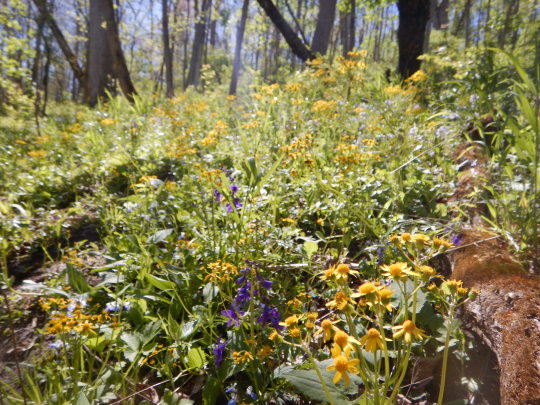
Packera obovata, Golden Roundleaf Groundsel and Delphinium tricorne, Dwarf Larkspur
#Ohio#wildflowers#plantblr#botany#kawaii#plants#meadowcore#cottagecore#Forest#forestcore#camassia#camassia scilloides#packera#packera obovata#delphinium tricorne#Delphinium
13 notes
·
View notes
Photo




Delphinium tricorne
(dwarf larkspur)
Ranunculaceae
Michx.
1 note
·
View note